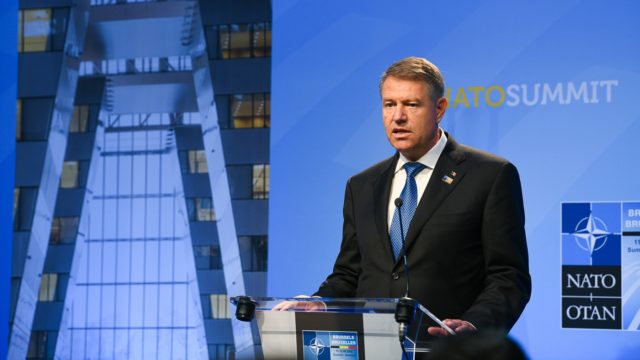
Romania at the Brussels Summit: A Less Than Expected Result
Publication: Eurasia Daily Monitor Volume: 15 Issue: 109
By:

As the recent (July 11–12) North Atlantic Treaty Organization (NATO) summit in Brussels, Belgium, came to a close, Romania’s foreign policy establishment put up a brave face and announced to the public that the country achieved everything it had set out to achieve (Radio România Internaţional, July 14). Yet, despite the positive message, Bucharest’s official assessment of the Brussels Summit appeared too optimistic.
Romania’s main objective at the NATO summit was to persuade the Alliance to treat the Baltic and Black Sea portions of Europe’s eastern flank with the same level of seriousness. Bucharest perceives an imbalance regarding the security NATO’s east. The Baltic Sea receives too many resources, while the Black Sea obtains fewer (see EDM, July 15, 2016), despite the fact that the latter has been the primary focus of Russia’s aggressive revisionism and military buildup over the past decade (see EDM, June 24, 2016; April 12, 2017; January 19, 2018). Furthermore, despite Russia’s aggressive behavior, NATO members in the Black Sea region do not share the same threat perception as do the member states in the Baltic. It is therefore exceptionally difficult to come up with a common regional security approach, greatly frustrating Romania’s diplomatic position on the Alliance’s eastern flank.
Before the Brussels Summit, Romania’s President Klaus Iohannis used the so-called “Bucharest Nine” format (Romania, Poland, Estonia, Lithuania, Latvia, Slovakia, the Czech Republic, Hungary and Bulgaria) to call for an integrated and comprehensive approach to the security of NATO’s eastern member states: “[W]e have to consolidate the Eastern Flank of NATO, and this has to happen in a coherent and integrated manner” (Presidency.ro, June 8). Earlier, in April 2018, President Iohannis was even more direct: “We need a better defended Eastern Flank, including through a unitary forward presence based on an integrated approach from the North to the South, from the Baltic Sea to the Black Sea” (Presidency.ro, April 19).
In practical terms, Romania wants to have the same status as Poland and the Baltic States when it comes to the US and NATO military footprint on its territory (RCD.com, July 18). Romania wants the “enhanced tailored presence” approved in 2016 at the NATO Warsaw summit to be upgraded to “enhanced forward presence.” In order to convince its allies, Bucharest has shown over the past two years that it is willing to take more of the defense burden in the Black Sea region by allocating 2 percent of GDP to its defense. As part of this defense drive, Romania has offered to extend and modernize the Mihail Kogălniceanu (M-K) Air Base, presently used by the US (Calea Europeană, February 15), in order to secure a permanent US presence on its territory. Furthermore, Bucharest plans to deploy more troops to Afghanistan, with Romania’s contribution rising from around 770 personnel to more than 950 (RRA, July 13).
After the summit, President Iohannis presented the main gains for Romania; but his tally simply did not add up. According to the head of state, Romania obtained a corps-level command on its territory, a permanent status for the multinational brigade deployed on its territory, and an entire session of the summit was dedicated to the issues of the Black Sea region (Presidency.ro, July 12). However, the “Brussels Summit Declaration” only “notes” Romania’s offer for a corps-level command; it does not explicitly establish one on its territory. Meanwhile, concerning the multinational brigade stationed near Craiova, the change in status was routine—part of the operational framework agreed to, two years ago, at the Warsaw Summit (Nato.int, July 11). Finally, the documents that have come out from the session Iohannis referred to—“Meeting of the North Atlantic Council at the level of Heads of State and Government with Georgia and Ukraine”—make no reference to Romania and deal only with issues affecting these two NATO-partner states (Nato.int [1], [2], July 12). Furthermore, nothing in the public record suggests, as Iohannis did, that the session itself was actually called at Romania’s request (Presidency.ro, July 12).
Given the incongruity between the upbeat tone of the Romanian delegation and the results of this month’s Brussels Summit, as reflected in the official documents, it seems that Bucharest obtained quite little—presumably, hence the need to talk up the policy outcomes for the public at home. The objective of gaining parity with Poland and the Baltic States in terms of Southeastern Europe’s status on the eastern flank was not accomplished. Romania’s offer to host a corps-level command may be approved at a follow up ministerial meeting, but this approval has yet to be obtained. Moreover, it is not clear if Bucharest managed to convince the other Allies of its vision concerning the Black Sea region, despite the fact that the region features prominently in the Summit Declaration (NATO, July 11). In terms of policy, the Brussels Summit was largely a disappointment for Romania.



